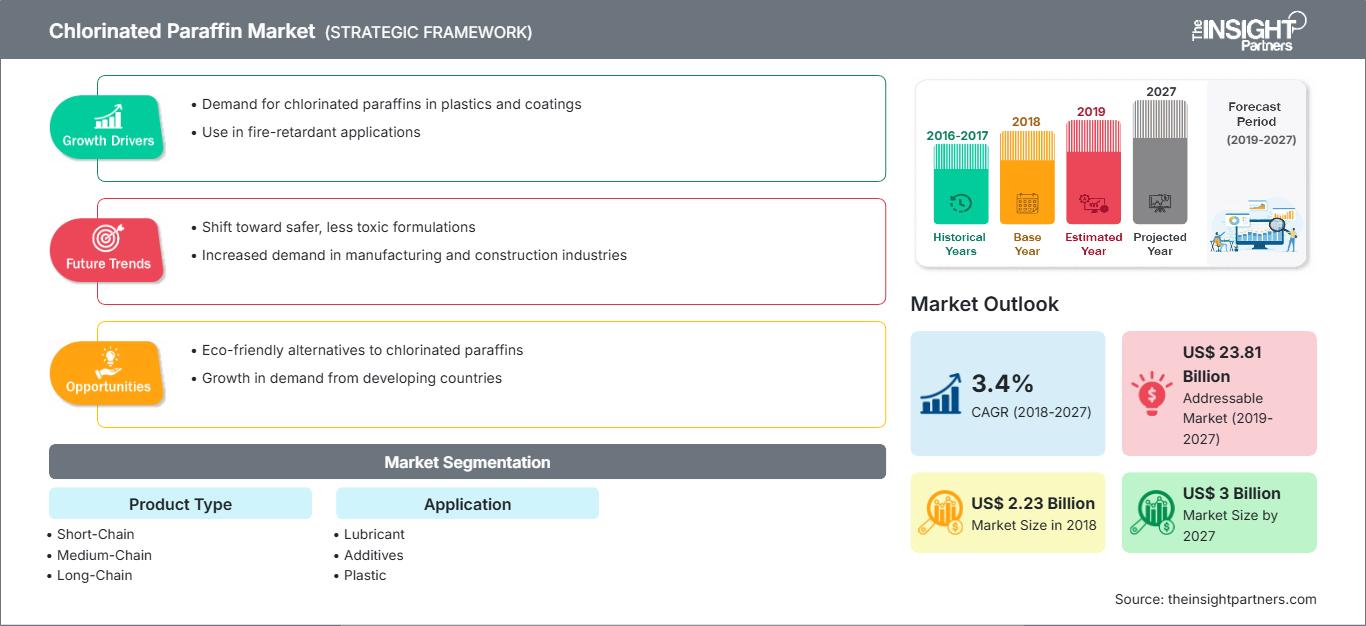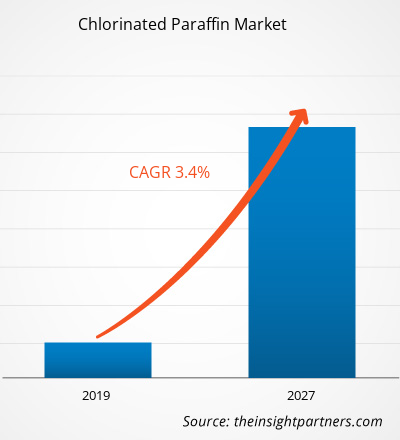Der globale Markt für chloriertes Paraffin belief sich 2018 auf 2.226,3 Mio. USD und wird im Prognosezeitraum 2019–2027 voraussichtlich mit einer durchschnittlichen jährlichen Wachstumsrate von 3,4 % wachsen und bis 2027 3.002,5 Mio. USD erreichen.
Der asiatisch-pazifische Raum hatte den größten Marktanteil am globalen Markt für chloriertes Paraffin. Das Wachstum des Marktes für chloriertes Paraffin in dieser Region ist hauptsächlich auf die schnelle Industrialisierung in Industrie- und Entwicklungsländern wie China, Indien, Japan und Australien zurückzuführen. Die wachsende Anzahl von Anwendungen für chloriertes Paraffin in zahlreichen Endverbrauchersektoren, darunter Farben und Lacke, elektronische Geräte sowie Bauwesen, wird somit die Nachfrage nach chloriertem Paraffin im asiatisch-pazifischen Raum erhöhen. Darüber hinaus wird erwartet, dass die zunehmende Aufmerksamkeit auf die Brandschutzgesetze in Australien, Japan und Singapur die Nachfrage nach chloriertem Paraffin im Prognosezeitraum weiter ankurbelt. Darüber hinaus sind die steigende Produktion von Schmiermittelzusätzen, Kunststoffen, Gummi und Farben unter anderem die Hauptfaktoren, die den Akteuren auf dem Markt für chlorierte Paraffine lukrative Wachstumschancen bieten.
Passen Sie diesen Bericht Ihren Anforderungen an
Sie erhalten kostenlos Anpassungen an jedem Bericht, einschließlich Teilen dieses Berichts oder einer Analyse auf Länderebene, eines Excel-Datenpakets sowie tolle Angebote und Rabatte für Start-ups und Universitäten.
Markt für chloriertes Paraffin: Strategische Einblicke

- Holen Sie sich die wichtigsten Markttrends aus diesem Bericht.Dieses KOSTENLOSE Beispiel umfasst Datenanalysen, die von Markttrends bis hin zu Schätzungen und Prognosen reichen.
Markteinblicke: Steigende Nachfrage nach Metallbearbeitungsflüssigkeiten
Sie erhalten kostenlos Anpassungen an jedem Bericht, einschließlich Teilen dieses Berichts oder einer Analyse auf Länderebene, eines Excel-Datenpakets sowie tolle Angebote und Rabatte für Start-ups und Universitäten.
Markt für chloriertes Paraffin: Strategische Einblicke

- Holen Sie sich die wichtigsten Markttrends aus diesem Bericht.Dieses KOSTENLOSE Beispiel umfasst Datenanalysen, die von Markttrends bis hin zu Schätzungen und Prognosen reichen.
Chloriertes Paraffin wird als Hochdruckadditiv in Metallbearbeitungsflüssigkeiten verwendet. Im Allgemeinen werden MCCPs und LCCPs bei der Herstellung von Metallbearbeitungsflüssigkeiten eingesetzt. Es wird für industrielle Getriebeschmierstoffe verwendet. Durch die Zugabe von chloriertem Paraffin in Metallbearbeitungsflüssigkeiten entsteht unter erschwerten Schmierbedingungen eine Metallsalzschicht oder ein kohlensäurehaltiger Film zwischen den beiden Metalloberflächen. Jeder Metallbearbeitungsvorgang erfordert präzise Flüssigkeitseigenschaften, die vom Metall und den Betriebsbedingungen abhängen. Bei Hochdruckadditiven gilt chloriertes Paraffin als die beste Option für präzise Flüssigkeitseigenschaften. Chloriertes Paraffin wird als Kühl- und Schmierflüssigkeit beim Schleifen und Zerspanen verwendet. Es gibt zwei Arten von chlorierten Paraffinflüssigkeiten: wasserbasierte Emulsionen und Ölschmiermittel. Die Grundfunktion wasserbasierter Schmiermittel ist die Kühlung. Metallbearbeitungsflüssigkeiten werden verwendet, um die Reibung zwischen der Arbeitsfläche und dem Schneidwerkzeug zu verringern. Die Zugabe von chloriertem Paraffin zu Metallbearbeitungsflüssigkeiten hilft, die Oberflächeneigenschaften des Metalls zu erhalten.
Chloriertes Paraffin wird als Hochdruckzusatz verwendet, der durch die Wärmeentwicklung bei der Metallbearbeitung aktiviert wird und einen Film zwischen dem Schneidwerkzeug und der Metalloberfläche bildet, der zerstörendes Schweißen, Oberflächenzersetzung und übermäßigen Metalltransfer verhindert. Daher wird erwartet, dass die steigende Nachfrage nach Metallbearbeitungsflüssigkeiten den globalen Markt für chloriertes Paraffin weiter ankurbelt.
Die Produktionsumstellung auf langkettiges chloriertes Paraffin bietet Wachstumschancen für den Markt für chloriertes Paraffin.
Die Nachfrage nach LCCPs ist in diesem Zeitraum gestiegen. Im Vergleich zu anderen chlorierten Paraffinen war der Einsatz von LCCPs in der Gummiindustrie sehr hoch. Die Möglichkeit des Einsatzes von LCCPs in einigen Bereichen könnte zunehmen, da es andere Arten von chloriertem Paraffin, insbesondere MCCPs, erfolgreich ersetzen kann. LCCPs haben sich in einigen Anwendungen als erfolgreiche Alternative erwiesen. Bei Farben erwiesen sich LCCPs als Korrosionsschutzgrundierung für metallbasierte PVC-Copolymere. Die Zugabe von LCCPs zu Acryl- und Außenwandfarben hat sich im Vergleich zur Verwendung von MCCPs als vorteilhaft und praktisch erwiesen, was das Wachstum des globalen Marktes für chlorierte Paraffine weiter vorantreibt.
LCCPs haben sich auch als wichtige Alternative in der Gummiindustrie etabliert. Die Anwendung von LCCPs bei der Herstellung von Profilen für Brandschutztüren hat sich als erfolgreich erwiesen und kann als Alternative zu MCCPs eingesetzt werden. Die Verwendung von LCCPs bei der Herstellung von Faltenbälgen für Busse, U-Bahnen und Züge ist ein weiterer Pluspunkt für die Anwendung von LCCPs als Alternative zu MCCPs. Daher wird erwartet, dass die steigende Nachfrage nach langkettigem Chlorparaffin den Akteuren der Branche auf dem globalen Markt für Chlorparaffin Wachstumschancen bietet.
Einblicke in Produkttypen
Der globale Markt für Chlorparaffin wurde nach Produkttypen in kurzkettige, mittelkettige und langkettige Produkte unterteilt. Das Segment der mittelkettigen Chlorparaffine dominierte den globalen Markt für Chlorparaffin. Darüber hinaus wird erwartet, dass das Segment der langkettigen Chlorparaffine im globalen Markt für Chlorparaffin im Prognosezeitraum schneller wachsen wird.
LCCPs sind frei von chlorierten Paraffinverunreinigungen. Die große Bandbreite der Kohlenstoffatomanzahl führt zur Komplexität des Produkts. LCCPs werden hauptsächlich als sekundärer Weichmacher in PVC und als Flammschutzmittel in Dichtstoffen, Klebstoffen und Farben verwendet. Die Feuerfestigkeit von Zellulosetextilien ist eine der wichtigsten Anwendungen von langkettigem Chlorparaffin. Es wird auch zur Behandlung fertiger Stoffe verwendet.
Anwendungseinblicke
Auf Basis der Anwendung wurde der globale Markt für Chlorparaffin in Schmierstoffzusätze, Kunststoff, Gummi, Farben, Metallbearbeitungsflüssigkeiten, Klebstoffe und andere unterteilt. Das breite Anwendungsspektrum von Chlorparaffin in verschiedenen Branchen bietet ein enormes Entwicklungspotenzial für den globalen Markt für Chlorparaffin. Unter den Anwendungssegmenten sind Schmierstoffzusätze das führende Segment auf dem globalen Markt für Chlorparaffin. Chlorparaffin wird als Metalltensid in Schmierstoffzusätzen verwendet. Hochdruckzusätze werden zur Herstellung hochwertiger Schmierstoffe formuliert. Hochdruckzusätze auf Basis von Chlorparaffin erfreuen sich weltweit zunehmender Beliebtheit. Diese Schmierstoffe reagieren chemisch mit der Metalloberfläche und bilden eine Schutzschicht, die verhindert, dass die beiden Metalloberflächen bei den hohen Temperaturen und Drücken, die beim Schmieren entstehen, zusammenschweißen. Chlorparaffin gilt in Ländern wie Indien und China als eines der wirksamsten Schmiermittel, was den Markt für Chlorparaffin im asiatisch-pazifischen Raum ankurbelt. Darüber hinaus treiben die steigende Nachfrage und Produktion von Schmiermittelzusätzen die Nachfrage nach Chlorparaffin in der Schmiermittelzusatzanwendung weiter an.
Fusionen und Übernahmen erwiesen sich als die am häufigsten angewandten Strategien auf dem globalen Markt für Chlorparaffin. Einige der jüngsten Entwicklungen auf dem globalen Markt für Chlorparaffin sind nachfolgend aufgeführt:
2018:
LEUNA-Tenside wurde von Vantage Specialty Chemicals Holdings Inc. übernommen, einem Unternehmen, das sich mit der Gewinnung natürlicher Inhaltsstoffe für die Endmärkte Körperpflege, Lebensmittel, Verbraucher und Industrie beschäftigt.2018:
Die Leuna-Tenside GmbH ist eine Partnerschaftsvereinbarung mit Oqema eingegangen, die es dem Unternehmen ermöglichen soll, in osteuropäische Märkte, einschließlich der Ukraine und Großbritannien, einzutreten und Marktkenntnisse zu erlangen. Darüber hinaus würde die breite Produktpalette von Leuna-Tenside das Portfolio von Oqema ergänzen.2017:
Química del Cinca erhielt zum zweiten Mal die Auszeichnung COASHIQ (Autonome Kommission für Sicherheit und Gesundheitsschutz am Arbeitsplatz in der chemischen Industrie) als Anerkennung für die Ergebnisse bei der Verhütung von Arbeitsunfällen im Jahr 2016, da ein NULL-Häufigkeitsindex registriert wurde.Chloriertes ParaffinRegionale Einblicke in den Markt für chloriertes Paraffin
Die Analysten von The Insight Partners haben die regionalen Trends und Faktoren, die den Markt für Chlorparaffin im Prognosezeitraum beeinflussen, ausführlich erläutert. In diesem Abschnitt werden auch die Marktsegmente und die geografische Lage in Nordamerika, Europa, dem asiatisch-pazifischen Raum, dem Nahen Osten und Afrika sowie Süd- und Mittelamerika erörtert.
Umfang des Marktberichts über chloriertes Paraffin
| Berichtsattribut | Einzelheiten |
|---|---|
| Marktgröße in 2018 | US$ 2.23 Billion |
| Marktgröße nach 2027 | US$ 3 Billion |
| Globale CAGR (2018 - 2027) | 3.4% |
| Historische Daten | 2016-2017 |
| Prognosezeitraum | 2019-2027 |
| Abgedeckte Segmente |
By Produkttyp
|
| Abgedeckte Regionen und Länder | Nordamerika
|
| Marktführer und wichtige Unternehmensprofile |
|
Dichte der Marktteilnehmer für chloriertes Paraffin: Verständnis ihrer Auswirkungen auf die Geschäftsdynamik
Der Markt für chlorierte Paraffine wächst rasant. Die steigende Nachfrage der Endverbraucher ist auf Faktoren wie veränderte Verbraucherpräferenzen, technologische Fortschritte und ein stärkeres Bewusstsein für die Produktvorteile zurückzuführen. Mit der steigenden Nachfrage erweitern Unternehmen ihr Angebot, entwickeln Innovationen, um den Bedürfnissen der Verbraucher gerecht zu werden, und nutzen neue Trends, was das Marktwachstum weiter ankurbelt.

- Holen Sie sich die Markt für chloriertes Paraffin Übersicht der wichtigsten Akteure
- Kurzkettig
- Mittelkettig
- Langkettig
Nach Anwendung
- Schmierstoffzusätze
- Kunststoff
- Gummi
- Farben
- Metallbearbeitungsflüssigkeiten
- Klebstoffe
- Sonstige
Nach Geografie
Nordamerika
- USA
- Kanada
- Mexiko
Europa
- Deutschland
- Frankreich
- Italien
- Großbritannien
- Russland
- Rest Europa
Asien-Pazifik
- Australien
- China
- Indien
- Japan
- Südkorea
- Rest des Asien-Pazifik-Raums
Naher Osten und Afrika (MEA)
- Südafrika
- Saudi-Arabien
- VAE
- Rest des MEA
Südamerika
- Brasilien
- Argentinien
- Rest Südamerika (SAM)
Firmenprofile
- Aditya Birla Chemicals
- Altair Chimica SpA
- Ajinomoto Fine-Techno Co., Inc.
- Caffaro Industrie SpA
- Dover Chemical Corporation
- Handy Chemical Corporation .ltd
- INEOS CHLOR
- KLJ Group
- LEUNA-Tenside GmbH
- Química Del Cinca
- Historische Analyse (2 Jahre), Basisjahr, Prognose (7 Jahre) mit CAGR
- PEST- und SWOT-Analyse
- Marktgröße Wert/Volumen – Global, Regional, Land
- Branchen- und Wettbewerbslandschaft
- Excel-Datensatz
Aktuelle Berichte
Erfahrungsberichte
Grund zum Kauf
- Fundierte Entscheidungsfindung
- Marktdynamik verstehen
- Wettbewerbsanalyse
- Kundeneinblicke
- Marktprognosen
- Risikominimierung
- Strategische Planung
- Investitionsbegründung
- Identifizierung neuer Märkte
- Verbesserung von Marketingstrategien
- Steigerung der Betriebseffizienz
- Anpassung an regulatorische Trends






















 Kostenlose Probe anfordern für - Markt für chloriertes Paraffin
Kostenlose Probe anfordern für - Markt für chloriertes Paraffin